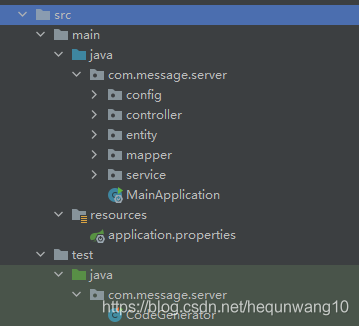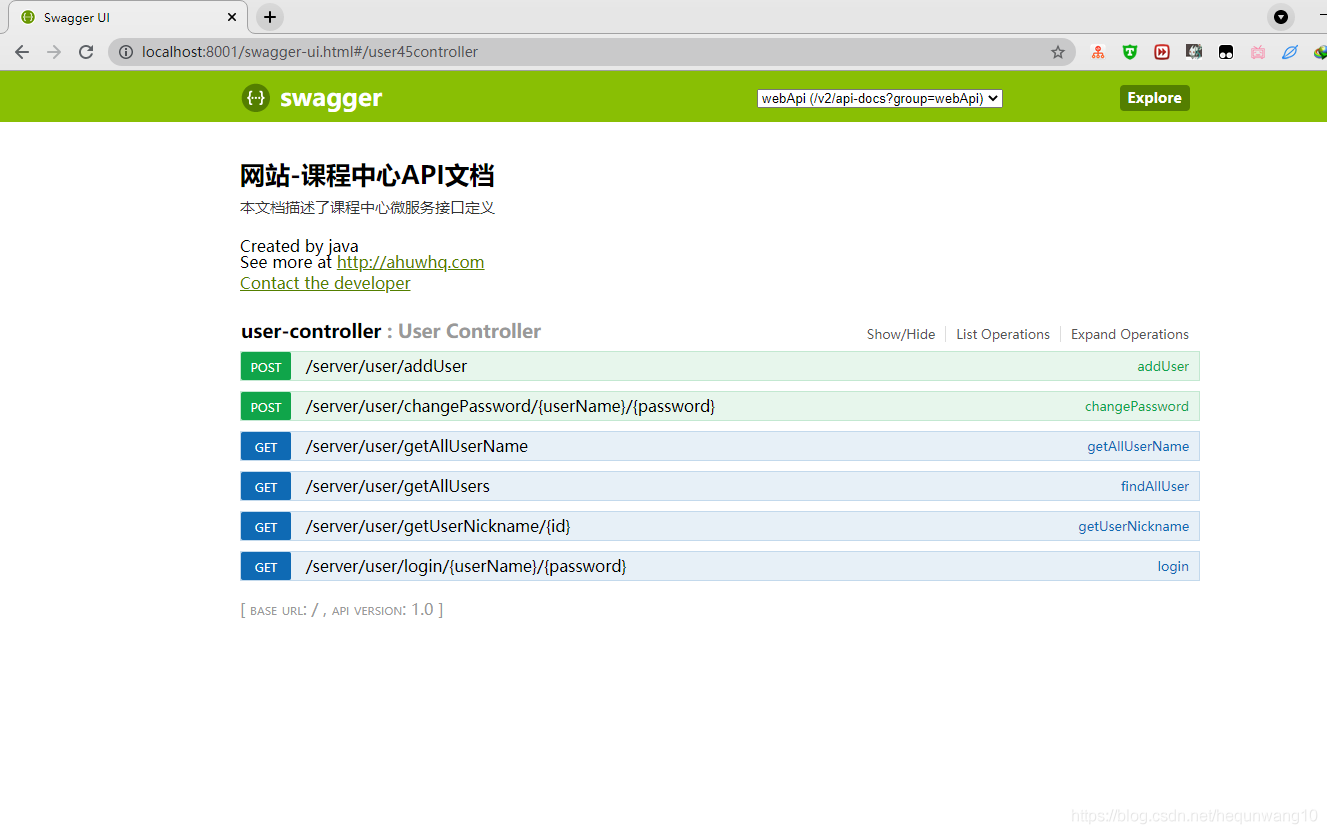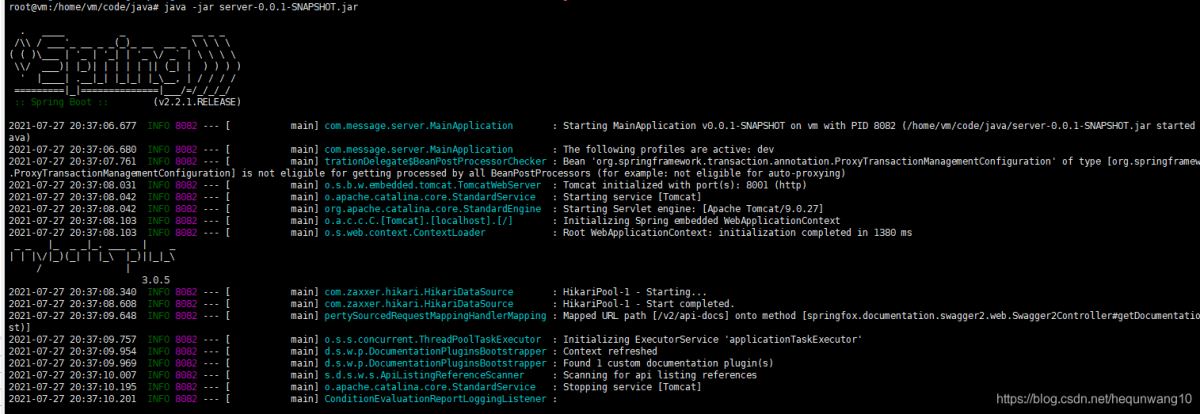Android使用OKhttp3實現登錄註冊功能+springboot搭建後端的詳細過程
一、Android前端實現
新建一個login的項目,主要的幾個文件在這裡

1、gradle引入OKhttp3依賴
implementation 'com.squareup.okhttp3:okhttp:3.14.7'
implementation 'com.squareup.okio:okio:1.17.5'
2、activity_main.xml佈局文件
<?xml version="1.0" encoding="utf-8"?>
<androidx.constraintlayout.widget.ConstraintLayout xmlns:android="http://schemas.android.com/apk/res/android"
xmlns:app="http://schemas.android.com/apk/res-auto"
xmlns:tools="http://schemas.android.com/tools"
android:layout_width="match_parent"
android:layout_height="match_parent"
tools:context=".MainActivity">
<EditText
android:id="@+id/username"
android:layout_width="wrap_content"
android:layout_height="wrap_content"
android:hint="用戶名"
android:textSize="34sp"
app:layout_constraintBottom_toBottomOf="parent"
app:layout_constraintEnd_toEndOf="parent"
app:layout_constraintStart_toStartOf="parent"
app:layout_constraintTop_toTopOf="parent"
app:layout_constraintVertical_bias="0.051" />
<EditText
android:id="@+id/password"
android:layout_width="wrap_content"
android:layout_height="wrap_content"
android:hint="密碼"
android:textSize="34sp"
app:layout_constraintBottom_toBottomOf="parent"
app:layout_constraintEnd_toEndOf="parent"
app:layout_constraintStart_toStartOf="parent"
app:layout_constraintTop_toBottomOf="@+id/username"
app:layout_constraintVertical_bias="0.067" />
<Button
android:id="@+id/button"
android:layout_width="wrap_content"
android:layout_height="wrap_content"
android:onClick="register"
android:text="註冊"
android:textSize="24sp"
app:backgroundTint="#E91E63"
app:layout_constraintBottom_toBottomOf="parent"
app:layout_constraintEnd_toEndOf="parent"
app:layout_constraintHorizontal_bias="0.501"
app:layout_constraintStart_toStartOf="parent"
app:layout_constraintTop_toBottomOf="@+id/password"
app:layout_constraintVertical_bias="0.058" />
<Button
android:id="@+id/getUser"
android:layout_width="wrap_content"
android:layout_height="wrap_content"
android:onClick="getUser"
android:text="獲取"
android:textSize="24sp"
app:backgroundTint="#E91E63"
app:layout_constraintBottom_toBottomOf="parent"
app:layout_constraintEnd_toEndOf="parent"
app:layout_constraintHorizontal_bias="0.501"
app:layout_constraintStart_toStartOf="parent"
app:layout_constraintTop_toBottomOf="@+id/button3"
app:layout_constraintVertical_bias="0.174" />
<Button
android:id="@+id/button3"
android:layout_width="wrap_content"
android:layout_height="wrap_content"
android:text="登錄"
android:textSize="24sp"
app:backgroundTint="#E91E63"
android:onClick="login"
app:layout_constraintBottom_toBottomOf="parent"
app:layout_constraintEnd_toEndOf="parent"
app:layout_constraintHorizontal_bias="0.501"
app:layout_constraintStart_toStartOf="parent"
app:layout_constraintTop_toBottomOf="@+id/button"
app:layout_constraintVertical_bias="0.113" />
</androidx.constraintlayout.widget.ConstraintLayout>
3、AndroidManifest.xml配置文件
這裡需要加上網絡請求權限,添加網絡權限的時候註意:在res目錄下新建xml目錄,創建network_security_config.xml文件
<?xml version="1.0" encoding="utf-8"?>
<network-security-config>
<base-config cleartextTrafficPermitted="true" />
</network-security-config>
並在配置文件中加入這行代碼:
android:networkSecurityConfig="@xml/network_security_config"
完整的AndroidManifest.xml文件如下
<?xml version="1.0" encoding="utf-8"?>
<manifest xmlns:android="http://schemas.android.com/apk/res/android"
package="com.example.login">
<uses-permission android:name="android.permission.INTERNET"/>
<uses-permission android:name="android.permission.WRITE_EXTERNAL_STORAGE" />
<uses-permission android:name="android.permission.READ_EXTERNAL_STORAGE" />
<application
android:allowBackup="true"
android:icon="@mipmap/ic_launcher"
android:label="@string/app_name"
android:roundIcon="@mipmap/ic_launcher_round"
android:networkSecurityConfig="@xml/network_security_config"
android:supportsRtl="true"
android:theme="@style/Theme.Login">
<activity android:name=".MainActivity">
<intent-filter>
<action android:name="android.intent.action.MAIN" />
<category android:name="android.intent.category.LAUNCHER" />
</intent-filter>
</activity>
</application>
</manifest>
4、創建User實體類
新建entity目錄創建User實體類。註意這裡我是根據後端數據庫的字段創建的,在實現登錄註冊的時候隻需要id,username,password 幾個基礎的字段就行,這裡我比較多,讀者可以自行忽略。
User.java
package com.example.login.entity;
public class User {
private Integer userId;
private String userName;
private String userPassword;
private String currentVersion;
private String latestVersion;
private String updateDescription;
private String headPortrait;
private String nickName;
private String vipTime;
private String userCategory;
private String registerDate;
public User(Integer userId, String userName, String userPassword, String currentVersion, String latestVersion, String updateDescription, String headPortrait, String nickName, String vipTime, String userCategory, String registerDate) {
this.userId = userId;
this.userName = userName;
this.userPassword = userPassword;
this.currentVersion = currentVersion;
this.latestVersion = latestVersion;
this.updateDescription = updateDescription;
this.headPortrait = headPortrait;
this.nickName = nickName;
this.vipTime = vipTime;
this.userCategory = userCategory;
this.registerDate = registerDate;
}
public User() {
}
public Integer getUserId() {
return userId;
}
public void setUserId(Integer userId) {
this.userId = userId;
}
public String getUserName() {
return userName;
}
public void setUserName(String userName) {
this.userName = userName;
}
public String getUserPassword() {
return userPassword;
}
public void setUserPassword(String userPassword) {
this.userPassword = userPassword;
}
public String getCurrentVersion() {
return currentVersion;
}
public void setCurrentVersion(String currentVersion) {
this.currentVersion = currentVersion;
}
public String getLatestVersion() {
return latestVersion;
}
public void setLatestVersion(String latestVersion) {
this.latestVersion = latestVersion;
}
public String getUpdateDescription() {
return updateDescription;
}
public void setUpdateDescription(String updateDescription) {
this.updateDescription = updateDescription;
}
public String getHeadPortrait() {
return headPortrait;
}
public void setHeadPortrait(String headPortrait) {
this.headPortrait = headPortrait;
}
public String getNickName() {
return nickName;
}
public void setNickName(String nickName) {
this.nickName = nickName;
}
public String getVipTime() {
return vipTime;
}
public void setVipTime(String vipTime) {
this.vipTime = vipTime;
}
public String getUserCategory() {
return userCategory;
}
public void setUserCategory(String userCategory) {
this.userCategory = userCategory;
}
public String getRegisterDate() {
return registerDate;
}
public void setRegisterDate(String registerDate) {
this.registerDate = registerDate;
}
}
LoginUser.java
public class LoginUser {
private String userName;
private String userPassword;
public LoginUser(String userName, String userPassword) {
this.userName = userName;
this.userPassword = userPassword;
}
public LoginUser() {
}
public String getUserName() {
return userName;
}
public void setUserName(String userName) {
this.userName = userName;
}
public String getUserPassword() {
return userPassword;
}
public void setUserPassword(String userPassword) {
this.userPassword = userPassword;
}
}
5、MainActivity.java
package com.example.login;
import androidx.appcompat.app.AppCompatActivity;
import android.os.Bundle;
import android.util.Log;
import android.view.View;
import android.widget.EditText;
import android.widget.TextView;
import android.widget.Toast;
import com.example.login.entity.User;
import org.json.JSONException;
import org.json.JSONObject;
import java.io.IOException;
import okhttp3.Call;
import okhttp3.Callback;
import okhttp3.MediaType;
import okhttp3.OkHttpClient;
import okhttp3.Request;
import okhttp3.RequestBody;
import okhttp3.Response;
public class MainActivity extends AppCompatActivity {
private EditText username;
private EditText password;
private User user;
@Override
protected void onCreate(Bundle savedInstanceState) {
super.onCreate(savedInstanceState);
setContentView(R.layout.activity_main);
username = findViewById(R.id.username);
password = findViewById(R.id.password);
}
public void register(View view) {
user = new User();
user.setUserName(username.getText().toString());
user.setUserPassword(password.getText().toString());
Log.d("whqusername",username.getText().toString());
Log.d("whqpassword",password.getText().toString());
new Thread(new Runnable() {
@Override
public void run() {
MediaType JSON = MediaType.parse("application/json;charset=utf-8");
JSONObject jsonObject = new JSONObject();
OkHttpClient httpClient = new OkHttpClient();
try {
jsonObject.put("userId",10);
jsonObject.put("userName",user.getUserName());
jsonObject.put("userPassword",user.getUserPassword());
jsonObject.put("currentVersion",null);
jsonObject.put("latestVersion",null);
jsonObject.put("updateDescription",null);
jsonObject.put("headPortrait",null);
jsonObject.put("nickName",user.getUserName());
jsonObject.put("vipTime",null);
jsonObject.put("userCategory",null);
jsonObject.put("registerDate",null);
} catch (JSONException e) {
e.printStackTrace();
}
RequestBody requestBody = RequestBody.create(JSON, String.valueOf(jsonObject));
String url = "http://ip:8001/server/user/addUser/";
Request request = new Request.Builder()
.url(url)
.post(requestBody)
.build();
Call call = httpClient.newCall(request);
call.enqueue(new Callback() {
@Override
public void onFailure(Call call, IOException e) {
Log.d("whq","失敗瞭");
}
@Override
public void onResponse(Call call, Response response) throws IOException {
Log.d("whq",response.toString()+"------------------");
Log.d("whq",response.body().toString()+"------------------");
}
});
}
}).start();
}
public void getUser(View view) {
OkHttpClient httpClient = new OkHttpClient();
String url = "http://ip:8001/server/user/getAllUserName";
Request getRequest = new Request.Builder()
.url(url)
.get()
.build();
Call call = httpClient.newCall(getRequest);
new Thread(new Runnable() {
@Override
public void run() {
try {
//同步請求,要放到子線程執行
Response response = call.execute();
Log.i("whq+getAllUserName", "okHttpGet run: response:"+ response.body().string());
} catch (IOException e) {
e.printStackTrace();
}
}
}).start();
}
public void login(View view) {
loginUser = new LoginUser();
loginUser.setUserName(username.getText().toString());
loginUser.setUserPassword(password.getText().toString());
new Thread(new Runnable() {
@Override
public void run() {
MediaType JSON = MediaType.parse("application/json;charset=utf-8");
JSONObject jsonObject = new JSONObject();
OkHttpClient httpClient = new OkHttpClient();
try {
jsonObject.put("userName",loginUser.getUserName());
jsonObject.put("userPassword",MD5.encrypt(loginUser.getUserPassword()));
} catch (JSONException e) {
e.printStackTrace();
}
RequestBody requestBody = RequestBody.create(JSON, String.valueOf(jsonObject));
String url = "http://ip:8001/server/user/login";
Request request = new Request.Builder()
.url(url)
.post(requestBody)
.build();
Call call = httpClient.newCall(request);
call.enqueue(new Callback() {
@Override
public void onFailure(Call call, IOException e) {
Log.d("whq登錄","失敗瞭");
}
@Override
public void onResponse(Call call, Response response) throws IOException {
String MyResult = response.body().string();
Log.d("whq登錄",response+"---------response---------");
Log.d("whq登錄",response.message()+"---------message---------");
Log.d("whq登錄",response.body().toString()+"------------------");
Log.d("whq登錄",MyResult+"-----------MyResult-------");
}
});
}
}).start();
}
}
到這裡就實現瞭Android的前端實現。
二、數據庫
數據庫就是簡單的一個user表
SET NAMES utf8mb4; SET FOREIGN_KEY_CHECKS = 0; -- ---------------------------- -- Table structure for user -- ---------------------------- DROP TABLE IF EXISTS `user`; CREATE TABLE `user` ( `userId` int(11) NOT NULL AUTO_INCREMENT, `userName` varchar(255) CHARACTER SET utf8 COLLATE utf8_general_ci NOT NULL, `userPassword` varchar(255) CHARACTER SET utf8 COLLATE utf8_general_ci NULL DEFAULT NULL, `currentVersion` varchar(255) CHARACTER SET utf8 COLLATE utf8_general_ci NULL DEFAULT NULL, `latestVersion` varchar(255) CHARACTER SET utf8 COLLATE utf8_general_ci NULL DEFAULT NULL, `updateDescription` varchar(255) CHARACTER SET utf8 COLLATE utf8_general_ci NULL DEFAULT NULL, `headPortrait` mediumblob NULL, `nickName` varchar(255) CHARACTER SET utf8 COLLATE utf8_general_ci NULL DEFAULT NULL, `vipTime` varchar(255) CHARACTER SET utf8 COLLATE utf8_general_ci NULL DEFAULT NULL, `userCategory` varchar(50) CHARACTER SET utf8 COLLATE utf8_general_ci NULL DEFAULT 'normal', `registerDate` varchar(50) CHARACTER SET utf8 COLLATE utf8_general_ci NULL DEFAULT NULL, PRIMARY KEY (`userId`, `userName`) USING BTREE ) ENGINE = InnoDB AUTO_INCREMENT = 13 CHARACTER SET = utf8 COLLATE = utf8_general_ci ROW_FORMAT = DYNAMIC; SET FOREIGN_KEY_CHECKS = 1;
三、SpringBoot後端搭建
後端搭建用到的是SSM框架
1、新建一個springboot項目,添加依賴
pom.xml文件。這裡有mybatis-plus+swagger+velocity,使用瞭代碼生成器
<properties>
<java.version>1.8</java.version>
<mybatis-plus.version>3.0.5</mybatis-plus.version>
<swagger.version>2.7.0</swagger.version>
<jodatime.version>2.10.1</jodatime.version>
<poi.version>3.17</poi.version>
<httpclient.version>4.5.1</httpclient.version>
<gson.version>2.8.2</gson.version>
<velocity.version>2.0</velocity.version>
</properties>
<dependencies>
<dependency>
<groupId>org.springframework.boot</groupId>
<artifactId>spring-boot-starter</artifactId>
</dependency>
<dependency>
<groupId>org.springframework.boot</groupId>
<artifactId>spring-boot-starter-test</artifactId>
<scope>test</scope>
</dependency>
<!--Spring Cloud-->
<dependency>
<groupId>org.springframework.cloud</groupId>
<artifactId>spring-cloud-dependencies</artifactId>
<version>Hoxton.RELEASE</version>
<type>pom</type>
<scope>import</scope>
</dependency>
<!--mybatis-plus 持久層-->
<dependency>
<groupId>com.baomidou</groupId>
<artifactId>mybatis-plus-boot-starter</artifactId>
<version>${mybatis-plus.version}</version>
</dependency>
<!-- velocity 模板引擎, Mybatis Plus 代碼生成器需要 -->
<dependency>
<groupId>org.apache.velocity</groupId>
<artifactId>velocity-engine-core</artifactId>
<version>${velocity.version}</version>
</dependency>
<!--swagger-->
<dependency>
<groupId>io.springfox</groupId>
<artifactId>springfox-swagger2</artifactId>
<version>${swagger.version}</version>
</dependency>
<!--swagger ui-->
<dependency>
<groupId>io.springfox</groupId>
<artifactId>springfox-swagger-ui</artifactId>
<version>${swagger.version}</version>
</dependency>
<!--日期時間工具-->
<dependency>
<groupId>joda-time</groupId>
<artifactId>joda-time</artifactId>
<version>${jodatime.version}</version>
</dependency>
<!--mysql-->
<dependency>
<groupId>mysql</groupId>
<artifactId>mysql-connector-java</artifactId>
</dependency>
<!--lombok用來簡化實體類:需要安裝lombok插件-->
<dependency>
<groupId>org.projectlombok</groupId>
<artifactId>lombok</artifactId>
</dependency>
<dependency>
<groupId>org.springframework.boot</groupId>
<artifactId>spring-boot-starter-web</artifactId>
</dependency>
</dependencies>
2、application.properties文件
# 服務端口 server.port=8001 # 服務名 spring.application.name=heartrate # 環境設置:dev、test、prod spring.profiles.active=dev # mysql數據庫連接 spring.datasource.driver-class-name=com.mysql.cj.jdbc.Driver spring.datasource.url=jdbc:mysql://ip:3310/heartrate?serverTimezone=GMT%2B8&useSSL=false spring.datasource.username=root spring.datasource.password=123456 #返回json的全局時間格式 spring.jackson.date-format=yyyy-MM-dd HH:mm:ss spring.jackson.time-zone=GMT+8 ##mybatis日志//要使用logback日志,就需要註釋掉 #mybatis-plus.configuration.log-impl=org.apache.ibatis.logging.stdout.StdOutImpl #配置mapper xml文件的路徑 mybatis-plus.mapper-locations=classpath:com/atguigu/eduservice/mapper/xml/*.xml
這裡的數據庫連接發現我是使用3310端口,因為我的服務器是使用docker創建數據庫的。請自行查看我之前的文章。
3、CodeGenerator.java代碼生成器
import com.baomidou.mybatisplus.annotation.DbType;
import com.baomidou.mybatisplus.annotation.IdType;
import com.baomidou.mybatisplus.generator.AutoGenerator;
import com.baomidou.mybatisplus.generator.config.DataSourceConfig;
import com.baomidou.mybatisplus.generator.config.GlobalConfig;
import com.baomidou.mybatisplus.generator.config.PackageConfig;
import com.baomidou.mybatisplus.generator.config.StrategyConfig;
import com.baomidou.mybatisplus.generator.config.rules.DateType;
import com.baomidou.mybatisplus.generator.config.rules.NamingStrategy;
import org.junit.Test;
/**
* @author ahuwhq
* @since 2021/7/27
*/
public class CodeGenerator {
@Test
public void run() {
// 1、創建代碼生成器
AutoGenerator mpg = new AutoGenerator();
// 2、全局配置
GlobalConfig gc = new GlobalConfig();
String projectPath = System.getProperty("user.dir");
//這裡改成自己的目錄
gc.setOutputDir("E:\\LaboratoryCode\\service\\server" + "/src/main/java");
gc.setAuthor("ahuwhq");
gc.setOpen(false); //生成後是否打開資源管理器
gc.setFileOverride(false); //重新生成時文件是否覆蓋
gc.setServiceName("%sService"); //去掉Service接口的首字母I
gc.setIdType(IdType.ID_WORKER_STR); //主鍵策略
gc.setDateType(DateType.ONLY_DATE);//定義生成的實體類中日期類型
gc.setSwagger2(true);//開啟Swagger2模式
mpg.setGlobalConfig(gc);
// 3、數據源配置
DataSourceConfig dsc = new DataSourceConfig();
//這裡的數據庫改為自己的
dsc.setUrl("jdbc:mysql://ip:3310/heartrate?serverTimezone=GMT%2B8");
dsc.setDriverName("com.mysql.cj.jdbc.Driver");
dsc.setUsername("root");
dsc.setPassword("123456");
dsc.setDbType(DbType.MYSQL);
mpg.setDataSource(dsc);
// 4、包配置
PackageConfig pc = new PackageConfig();
pc.setParent("com.message");
pc.setModuleName("server"); //模塊名
pc.setController("controller");
pc.setEntity("entity");
pc.setService("service");
pc.setMapper("mapper");
mpg.setPackageInfo(pc);
// 5、策略配置
StrategyConfig strategy = new StrategyConfig();
//這裡是對應的數據庫的表
strategy.setInclude("user");
strategy.setNaming(NamingStrategy.underline_to_camel);//數據庫表映射到實體的命名策略
strategy.setTablePrefix(pc.getModuleName() + "_"); //生成實體時去掉表前綴
strategy.setColumnNaming(NamingStrategy.underline_to_camel);//數據庫表字段映射到實體的命名策略
strategy.setEntityLombokModel(true); // lombok 模型 @Accessors(chain = true) setter鏈式操作
strategy.setRestControllerStyle(true); //restful api風格控制器
strategy.setControllerMappingHyphenStyle(true); //url中駝峰轉連字符
mpg.setStrategy(strategy);
// 6、執行
mpg.execute();
}
}
點擊運行就會自動生成文件

4、添加config目錄
這裡的config目錄代碼生成器沒有幫我們生成,我們添加這個目錄主要是想使用swagger測試(SwaggerConfig),並且代碼生成器生成文件之後,我們需要配置一下能掃描到mapper文件(ServerConfig)
ServerConfig.java
package com.message.server.config;
import com.baomidou.mybatisplus.core.injector.ISqlInjector;
import com.baomidou.mybatisplus.extension.injector.LogicSqlInjector;
import com.baomidou.mybatisplus.extension.plugins.PaginationInterceptor;
import org.mybatis.spring.annotation.MapperScan;
import org.springframework.context.annotation.Bean;
import org.springframework.context.annotation.Configuration;
@Configuration
@MapperScan("com.message.server.mapper")
public class ServerConfig {
/**
* 邏輯刪除插件
*/
@Bean
public ISqlInjector sqlInjector() {
return new LogicSqlInjector();
}
/**
* 分頁插件
*/
@Bean
public PaginationInterceptor paginationInterceptor() {
return new PaginationInterceptor();
}
}
SwaggerConfig.java
import com.google.common.base.Predicates;
import org.springframework.context.annotation.Bean;
import org.springframework.context.annotation.Configuration;
import springfox.documentation.builders.ApiInfoBuilder;
import springfox.documentation.builders.PathSelectors;
import springfox.documentation.service.ApiInfo;
import springfox.documentation.service.Contact;
import springfox.documentation.spi.DocumentationType;
import springfox.documentation.spring.web.plugins.Docket;
import springfox.documentation.swagger2.annotations.EnableSwagger2;
@Configuration//配置類
@EnableSwagger2//swagger2註解
public class SwaggerConfig {
@Bean
public Docket webApiConfig(){
return new Docket(DocumentationType.SWAGGER_2)
.groupName("webApi")
.apiInfo(webApiInfo())
.select()
// .paths(Predicates.not(PathSelectors.regex("/admin/.*")))
.paths(Predicates.not(PathSelectors.regex("/error.*")))
.build();
}
private ApiInfo webApiInfo(){
return new ApiInfoBuilder()
.title("網站-課程中心API文檔")
.description("本文檔描述瞭課程中心微服務接口定義")
.version("1.0")
.contact(new Contact("java", "http://ahuwhq.com", "ahuwhq@163.com"))
.build();
}
}
5、Controller層實現 UserController.java
這裡我實現瞭好多種方法,不僅是登錄註冊,但是Android前段我們隻用到登錄註冊和獲取全部用戶
import com.message.server.entity.User;
import com.message.server.entity.vo.UserAll;
import com.message.server.service.UserService;
import org.springframework.beans.factory.annotation.Autowired;
import org.springframework.web.bind.annotation.*;
import java.util.List;
/**
* <p>
* 前端控制器
* </p>
*
* @author ahuwhq
* @since 2021-07-27
*/
@RestController
@RequestMapping("/server/user")
public class UserController {
//訪問地址:http://ip:8001/server/user/findAll 最終部署到服務器時使用這個來訪問
//訪問地址:http://localhost:8001/server/user/findAll 這是本地測試地址也是Swagger地址
@Autowired
private UserService userService;
/**
* 查詢所有的用戶
* @return
*/
@GetMapping("getAllUsers")
public List<User> findAllUser(){
//調用方法查詢
List<User> list = userService.list(null);
return list;
}
/**
* 添加用戶,註冊功能
* @param user
* @return
*/
@PostMapping("addUser")
public Boolean addUser(@RequestBody User user){
boolean save = userService.save(user);
return save;
}
/**
* 獲取所有用戶名
*/
@GetMapping("getAllUserName")
public List<UserAll> getAllUserName(){
List<UserAll> userNamelist = userService.getAllUserName();
return userNamelist;
}
/**
* 根據用戶ID查詢用戶的昵稱
* @param id
* @return
*/
@GetMapping("getUserNickname/{id}")
public String getUserNickname(@PathVariable Integer id){
User user = userService.getById(id);
String nickName = user.getNickName();
return nickName;
}
/**
*修改密碼
* @param userName
* @return
*/
@PostMapping("changePassword/{userName}/{password}")
public Boolean changePassword(@PathVariable String userName,
@PathVariable String password){
Boolean result = userService.changePassword(userName,password);
return result;
}
/**
* 用戶的登錄功能PostMapping
* @param loginuser
* @return
*/
@PostMapping("login")
public R login(@RequestBody loginUser loginuser){
String token = userService.login(loginuser);
if (token == "wrong Password"){
return R.error().data("result",token);
}else{
return R.ok().data("result",token);
}
}
}
這裡用到瞭幾個文件R.java,ResultCode.java,MyException.java
R.java
//統一返回結果
import io.swagger.annotations.ApiModelProperty;
import lombok.Data;
import java.util.HashMap;
import java.util.Map;
@Data
public class R {
@ApiModelProperty(value = "是否成功")
private Boolean success;
@ApiModelProperty(value = "返回碼")
private Integer code;
@ApiModelProperty(value = "返回消息")
private String message;
@ApiModelProperty(value = "返回數據")
private Map<String, Object> data = new HashMap<String, Object>();
//構造方法私有化
private R(){}
//鏈式編程
//成功靜態方法
public static R ok(){
R r = new R();
r.setSuccess(true);
r.setCode(ResultCode.SUCCESS);
r.setMessage("成功");
return r;
}
//失敗靜態方法
public static R error(){
R r = new R();
r.setSuccess(false);
r.setCode(ResultCode.ERROR);
r.setMessage("失敗");
return r;
}
public R success(Boolean success){
this.setSuccess(success);
return this;
}
public R message(String message){
this.setMessage(message);
return this;
}
public R code(Integer code){
this.setCode(code);
return this;
}
public R data(String key, Object value){
this.data.put(key, value);
return this;
}
public R data(Map<String, Object> map){
this.setData(map);
return this;
}
}
ResultCode.java
public interface ResultCode {
public static Integer SUCCESS = 20000;//成功
public static Integer ERROR = 20001;//失敗
}
MyException.java
import lombok.AllArgsConstructor;
import lombok.Data;
import lombok.NoArgsConstructor;
@Data
@AllArgsConstructor//生成有參構造方法
@NoArgsConstructor//生成無參構造方法
public class MyException extends RuntimeException{
private Integer code;//狀態碼
private String msg;//異常信息
}
5、UserService接口
public interface UserService extends IService<User> {
/**
* 獲取所有用戶名
* @return
*/
List<UserAll> getAllUserName();
/**
* 修改密碼
* @param userName
* @return
*/
Boolean changePassword(String userName,String password);
/**
* 用戶的登錄功能
* @param userName
* @param password
* @return
*/
Boolean login(String userName, String password);
}
6、UserServiceImpl.java
public class UserServiceImpl extends ServiceImpl<UserMapper, User> implements UserService {
@Autowired
private UserService userService;
/**
* 獲取所有用戶名
*/
@Override
public List<UserAll> getAllUserName() {
//創建一個構造器
QueryWrapper<User> wrapper = new QueryWrapper<>();
//查詢所有的userName
wrapper.eq("userName",0);
//重新封裝一個UserAll的類,專門來查詢所有用戶名
List<User> users = baseMapper.selectList(wrapper);
List<UserAll> userAlls = new ArrayList<>();
for (int i = 0; i < users.size(); i++) {
User user = users.get(i);
String userName = user.getUserName();
UserAll userAll = new UserAll();
userAll.setUserName(userName);
userAlls.add(userAll);
}
return userAlls ;
}
/**
* 修改密碼
* @param userName
* @param password
* @return
*/
@Override
public Boolean changePassword(String userName,String password) {
QueryWrapper<User> wrapper = new QueryWrapper<>();
wrapper.eq("userName",userName);
User user = baseMapper.selectOne(wrapper);
if (user == null){
return false;
}
user.setUserPassword(password);
boolean save = userService.update(user,null);
return save;
}
/**
* 用戶的登錄功能PostMapping
* @param loginuser
* @return
*/
@Override
public String login(loginUser loginuser) {
String userName = loginuser.getUserName();
String userPassword = loginuser.getUserPassword();
//用戶名和密碼非空判斷
if(org.springframework.util.StringUtils.isEmpty(userName) || org.springframework.util.StringUtils.isEmpty(userPassword)) {
return "wrong Password";
}
//判斷手機號是否正確
QueryWrapper<User> wrapper = new QueryWrapper<>();
wrapper.eq("userName",userName);
User user = baseMapper.selectOne(wrapper);
//判斷密碼
//因為存儲到數據庫密碼肯定加密的
//把輸入的密碼進行加密,再和數據庫密碼進行比較
//加密方式 MD5
if(!userPassword.equals(user.getUserPassword())) {
return "wrong Password";
}
else {
return "success login";
}
}
}
註意:第一個獲取所有用戶名的方法會發現我自己生成一個實體類,原因是我的數據庫表裡面有很多字段,但是我在前端展示的時候隻能顯示幾個字段,就是起到保護隱私安全的作用。所以我新建瞭UserAll類。不影響閱讀這些邏輯。

UserAll.java
@Data
public class UserAll {
private String userName;
}
7、運行springboot
這就是全部代碼,我們運行之後啟動成功。然後打開swagger測試

這裡就可以進行接口測試。這裡就不進行展示瞭。
四、部署至服務器
我們使用maven打包。點擊package。就可以生成jar包瞭。

然後上傳至服務器。

這裡我們就使用 java -jar server-0.0.1-SNAPSHOT.jar 命令運行起來就可以瞭。

這樣就跑起來瞭。
註意:
這裡有一個坑,要看服務器8001的端口有沒有開放,否則是不能通過ip訪問到的。
firewall-cmd --list-port firewall-cmd --zone=public --add-port=8001/tcp --permanent firewall-cmd --reload firewall-cmd --query-port=8001/tcp
firewall-cmd --zone=public --remove-port=8001/tcp --permanent # 刪除 netstat -anp|grep 8001

然後打開一個接口

五、運行測試
打開AS ,運行APP,打印日志

簡單的登錄註冊基本功能邏輯就已經實現瞭,大致流程可以走通。接下來就可以繼續開發其他瞭。
註:這裡隻是最基本的登錄註冊,還不完善,比如這裡密碼用戶名是明文傳送,很容易被抓包,所以這篇花瞭一點時間做的demo,並不完善,後面會補充完整。
到此這篇關於Android使用OKhttp3實現登錄註冊功能+springboot搭建後端的文章就介紹到這瞭,更多相關Android後端springboot內容請搜索WalkonNet以前的文章或繼續瀏覽下面的相關文章希望大傢以後多多支持WalkonNet!
推薦閱讀:
- SpringBoot如何獲取application.properties中自定義的值
- java fastjson傳輸long數據卻接收到瞭int的問題
- Java中常用解析工具jackson及fastjson的使用
- 如何使用ActiveMQ中間件方式發送郵件
- swagger @ApiModel添加實體類不生效的解決